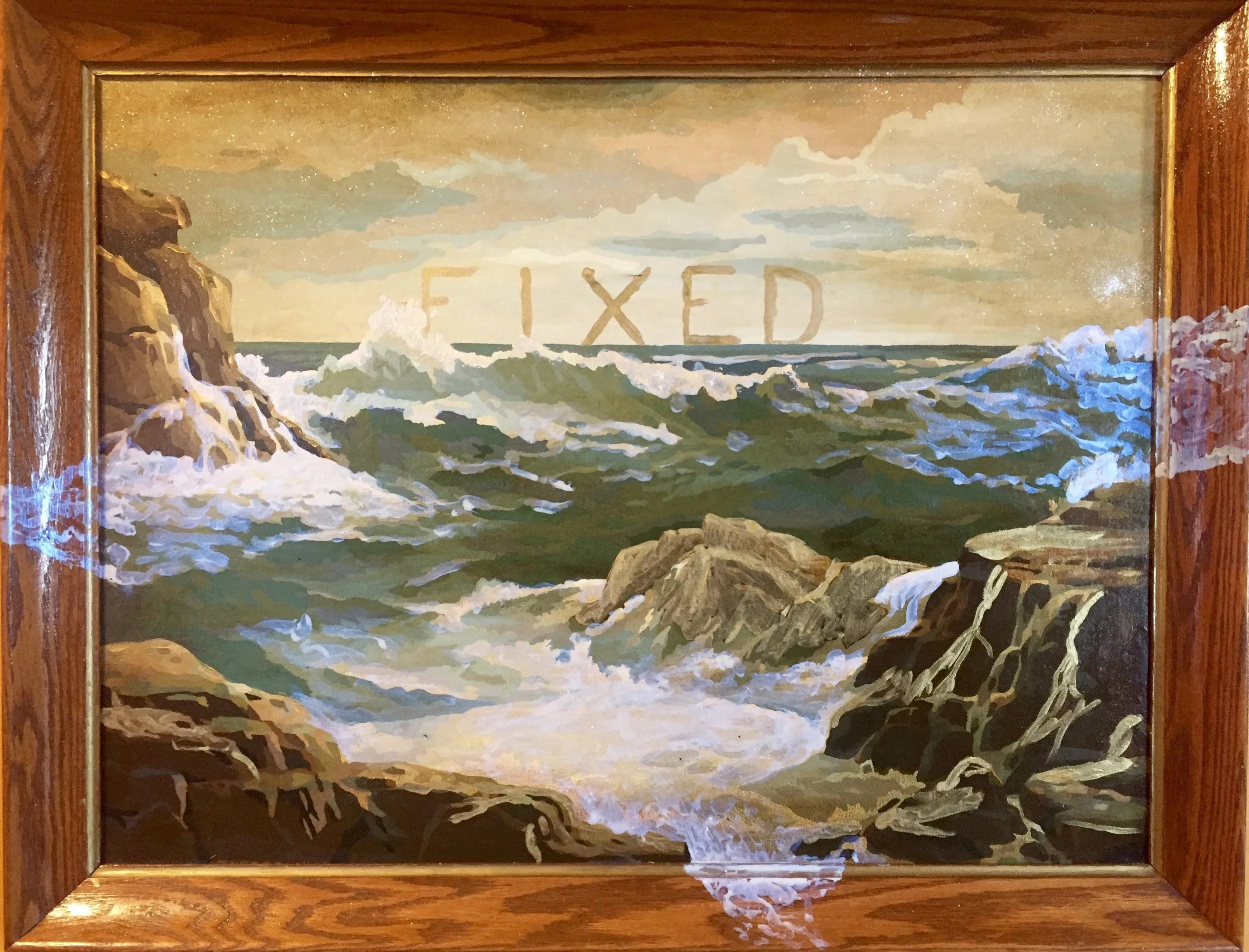Quantum Identity V: Perfecting Improvement, Improving Perfection
Acrylics, gold pulver, pearl powder, dichroic powder, mica flakes on a discarded board and frame.
My dearest friend, Deborah Baker, brought this painting to me, asking me to figure out whether or not it needed to be “Ericified.” She said she liked it, but also felt like maybe it could be improved.
I absolutely loved this painting, and thought it might just be perfect on its own, in its own way, but after a while, I acknowledged that Deborah was right: there was also room for improvement. Somehow it’s simplicity left the painting open to questioning, was this a beautiful study in simplifying shapes, or was this more like a good paint-by-numbers? I loved it as it was, but also thought it could be better.
I let the painting sit there in my living room in a prominent place so I could live with it and let it speak to me. I wanted to really get to know this piece. Did it really need help? There was something that I thought was gorgeous about it, and I loved the history, the shapes, the patina - and I loved the idea that no one could really decide whether or not it was fine as it was.
As I kept walking past the painting I kept looking into the horizon and kept subconsciously hearing it whisper, “Fix me.” This led to an internal dialogue with the painting, with me wrestling over whether or not I wanted to actually change it because I loved it just the way it was. Then it clicked: I really did love the painting, and in that sense of love and respect for it, I could tenderly and creatively bring new life to it too - improving the perfect.
Up until now I either completely covered or almost covered the pieces I’d done, leaving only traces of the old works, but I had the idea to create a series of translucent and transparent glazes to only improve the piece, honoring the original painting in a way I hadn’t done before. As a lifelong student of tea culture, I decided to use the Japanese art of Kintsugi as an inspiration.
Some of my favorite pieces of tea ware are old pieces that have been repaired with gold or silver, and when my grandmother’s precious Satsuma lamp broke into hundreds of pieces, my tea sensei generously and painstakingly repaired it with gold. Now the lamp still has all the memories of my grandmother, but is complimented with my gratitude and love for my tea sensei and this incredible gift he gave me in the restoration of what I thought was lost forever. The lamp was perfect before, but now it is worth even more to me, and it’s emotional and sentimental value is beyond what I thought it could have ever had. While it was a horrible loss at the time, I’m now grateful for the accident that broke the lamp, because it opened the door to something priceless. Since then, I have also learned this ancient art of traditional kintsugi, and it is an important part of my own life, art, and tea practice.
Using varying degrees of translucency in the glazes, and mixing real gold powder into varnish, I was able to preserve so much of the original painting, while also enhancing places I thought were a little too basic, or make some beautiful places even more beautiful. Mixing in mica flakes with gold and interference powders brought luminosity and shimmer to the flatness of the piece. Adding a word brought depth and meaning to an otherwise purely aesthetic painting.
Detail
The word “FIXED” floats there on (or just beyond) the horizon, and in its simplicity, it holds disparate meanings. Is the painting fixed now? Or is the idea of fixing something always off on the horizon, just out of reach? Or is it something looming on the horizon with every sunrise or sunset, promising renewal every day in inevitable cycles of loss and improvement? Or maybe the entire idea of “fixing” a thing or a thing needing to be fixed is a mirage or impossible goal, always “out there” somewhere, and if that is the case, is it worth pursuing anyway, or an exercise in futility? “Fixed” also means permanent or immovable, which speaks to our standards of perfection, but also speaks of the paralysis of actually improving something (including our lives and ourselves) if we remain attached to the present state of things, or if we are afraid of risk or change.
I loved the idea of having such a loaded word on a painting that looked like it could have been a paint-by-numbers piece. There is no real shading, no real mixing of colors in the original piece, and now there is a word standing there in obvious (and strange) context, and that word has so many meanings and brings up so many questions. Plus, the painting didn’t really mean anything before, and now it has layers and layers of questions that might not even have answers. And so the sea, which also has multiple layers of meaning (emotions, unexplored depths, danger, passage, opportunity, life…) escapes the frame, splashing out into real life with color-changing but translucent intensity.
Ultimately, what the piece represents to me is the idea that we really are all perfect and valuable in our beingness just as we are, and yet we are also presented with infinite opportunities to improve ourselves and our quality of life. This potential can be liberating or paralyzing, and can become a healthy way to live into our potential and self-acceptance or a crippling perfectionism. Dialectical Behavioral Therapy (DBT) explores this duality - we are all perfect, and we are all capable of improvement. In DBT, patients are unconditionally accepted as they are, and also acknowledge the need or desire for improvement, and eventually, hopefully, recovery becomes possible in the seemingly opposing forces of self-acceptance and acknowledgement of character defects. The more one accepts himself or herself unconditionally, despite their flaws, the more they begin to realize that they actually deserve to have a better, healthier, more fulfilling and integrated life. That’s what this painting became - something beautiful and perfect, while also being something capable of improvement. In making the piece, it became a prayer as well, for myself, for my friend, Deborah, who gave me the original painting, and for all future viewers who might need a reminder that perfection and improvement can coexist, that we all deserve our best lives, but that “best life” is full of imperfection, full of potential, and will never come if we don’t first learn to fully and unconditionally accept life as it is right now.
[SOLD] 40" x "31


